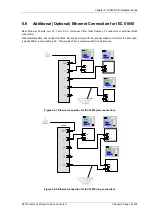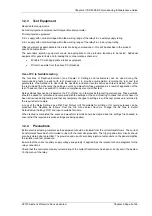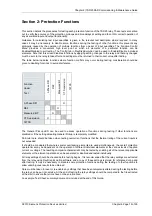
Chapter 6) 7SR23 DAD Commissioning & Maintenance Guide
©2013 Siemens Protection Devices Limited
Chapter 6 Page 5 of 26
Section 1: Common Functions
1.1
Overview
Commissioning tests are carried out to prove:
a) Equipment has not been damaged in transit.
b) Equipment has been correctly connected and installed.
c) Prove characteristics of the protection and settings which are based on calculations.
d) Confirm that settings have been correctly applied.
e) To obtain a set of test results for future reference.
1.2
Before Testing
1.2.1 Safety
The commissioning and maintenance of this equipment should only be carried out by skilled personnel trained in
protective relay maintenance and capable of observing all the safety precautions and regulations appropriate to
this type of equipment and also the associated primary plant.
Ensure that all test equipment and leads have been correctly maintained and are in good condition. It is
recommended that all power supplies to test equipment be connected via a Residual Current Device (RCD),
which should be located as close to the supply source as possible.
The choice of test instrument and test leads must be appropriate to the application. Fused instrument leads
should be used when measurements of power sources are involved, since the selection of an inappropriate range
on a multi-range instrument could lead to a dangerous flashover. Fused test leads should not be used where the
measurement of a current transformer (C.T.) secondary current is involved, the failure or blowing of an instrument
fuse or the operation of an instrument cut-out could cause the secondary winding of the C.T. to become an open
circuit.
Open circuit secondary windings on energised current transformers are a hazard that can produce high voltages
dangerous to personnel and damaging to equipment, test procedures must be devised so as to eliminate this risk.
1.2.2 Sequence of Tests
If other equipment is to be tested at the same time, then such testing must be co-ordinated to avoid danger to
personnel and/or equipment.
When all cabling and wiring is completed, a comprehensive check of all terminations for tightness and compliance
with the approved diagrams must be carried out. This can then be followed by the insulation resistance tests
which, if satisfactory allows the wiring to be energised by either the appropriate station supply or test supply.
When primary injection tests are completed satisfactorily, all remaining systems can be functionally tested before
the primary circuit is energised. Some circuits may require further tests before being put on load.
Protection relay testing will require access to the protection system wiring diagrams, relay configuration
information and protection settings. The following sequence of tests is loosely based on the arrangement of the
relay menu structure. A test log based on the actual tests completed should be recorded for each relay tested. A
typical example of this Site Test Sheet is included.
The ‘Description of Operation’ section of this manual provides detailed information regarding the operation of
each function of the relay.
Summary of Contents for 7SR23 DAD
Page 1: ...Answers for energy 7SR23 DAD High Impedance Protection Relay Reyrolle Protection Devices ...
Page 2: ......
Page 4: ...7SR23 DAD Contents 2013 Siemens Protection Devices Limited ...
Page 60: ...Chapter 3 7SR23 DAD Performance Specification 2013 Siemens Protection Devices Limited ...
Page 225: ......
















































